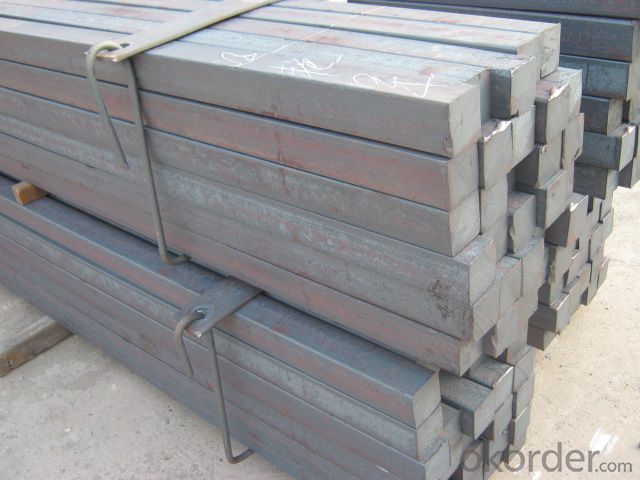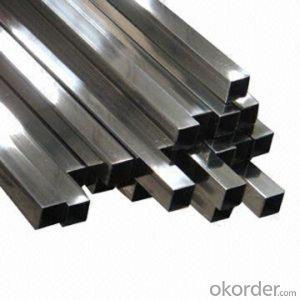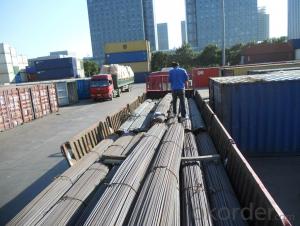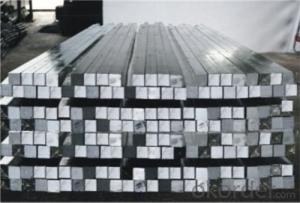Square Bar Hot Rolled High Quality Q235 Or Q195
- Loading Port:
- Tianjin
- Payment Terms:
- TT OR LC
- Min Order Qty:
- 25 m.t.
- Supply Capability:
- 2000000 m.t./month
OKorder Service Pledge
OKorder Financial Service
You Might Also Like
Item specifice
Product Description:
OKorder is offering high quality Hot Rolled Steel I-Beams at great prices with worldwide shipping. Our supplier is a world-class manufacturer of steel, with our products utilized the world over. OKorder annually supplies products to European, North American and Asian markets. We provide quotations within 24 hours of receiving an inquiry and guarantee competitive prices.
Product Applications:
1) Suitable for making various strong cutting tool abrasion resistance, impact resistance.
2) Used to produce all kinds of high hard and super hard saw blade, drill, tap, broach, gear hob and various kinds of milling cutter.
3) Used for advanced punching die, screw die, and the toughness and complicated shape of the punch, etc.
4) Is used for cold forging die and drawing mode, etc.
5) Recommended watchcase factory, screw factory and other cold stamping products industry use.
Product Advantages:
OKorder's Steel I-Beams are durable, strong, and resist corrosion.
Main Product Features:
· Premium quality
· Prompt delivery & seaworthy packing (30 days after receiving deposit)
· Corrosion resistance
· Can be recycled and reused
· Mill test certification
· Professional Service
· Competitive pricing
Product Specifications:
Standard: GB,
-Grade: Q195 or equivalent.
-Chemical Composition:
Standard | Grade | Element (%) | ||||
GB | Q195 | C | Mn | S | P | Si |
0.06~0.12 | 0.25~0.50 | ≤0.050 | ≤0.045 | ≤0.30 | ||
Measures of HR Square Bar (small measures):
(Section of HR Square Bar)
-Length of a side and Theoretical weight of Square Bar.
Length of a side(mm) | Theoretical weight(kg/m) | Length of a side(mm) | Theoretical weight(kg/m) |
7 | 0.385 | 22 | 3.80 |
8 | 0.502 | 24 | 4.52 |
9 | 0.636 | 25 | 4.91 |
10 | 0.785 | 26 | 5.30 |
11 | 0.950 | 28 | 6.15 |
12 | 1.13 | 30 | 7.06 |
13 | 1.33 | 32 | 8.04 |
14 | 1.54 | 34 | 9.07 |
15 | 1.77 | 36 | 10.17 |
16 | 2.01 | 38 | 11.24 |
17 | 2.27 | 40 | 12.56 |
18 | 2.54 | 42 | 13.85 |
19 | 2.82 | 45 | 15.90 |
20 | 3.14 | 48 | 18.09 |
21 | 3.46 | 50 | 19.63 |
Notes:
1, The theoretical weights in the list, base on the density of 7.85 g/cm3.
2, Formula for theoretical weight of Square bar: (length of a side)2 * 0.00785
3, The numbers with *mean that they are not regular or we don’t offer them.
-Regular length of Square Bar:
Steel | Length of a side (mm) | Length of steel (m) |
Normal steel | < 25 | 4~10 |
> 25 | 3~9 | |
Steel of high quality | All measure | 2~6 |
Tool steel >75 | 1~6 |
FAQ:
Q1: How soon can we receive the product after purchase?
A1: Within three days of placing an order, we will begin production. The specific shipping date is dependent upon international and government factors, but is typically 7 to 10 workdays.
Q2: Can stainless steel rust?
A2: Stainless does not "rust" as you think of regular steel rusting with a red oxide on the surface that flakes off. If you see red rust it is probably due to some iron particles that have contaminated the surface of the stainless steel and it is these iron particles that are rusting. Look at the source of the rusting and see if you can remove it from the surface.
Q3: How do you package the angle steel when shipping?
A3: All goods are packed in bundles with steel strips and shipped by container or break bulk.


- Q:Can a steel square be used for beam layout and construction?
- Yes, a steel square can be used for beam layout and construction. A steel square is a versatile tool commonly used by carpenters and construction workers for measuring and marking angles, making it useful for laying out and constructing beams. Its durable steel construction ensures accuracy and reliability in beam layout and construction tasks.
- Q:How do you use a steel square to mark a line perpendicular to a board edge?
- To use a steel square to mark a line perpendicular to a board edge, you would align the long edge (blade) of the square against the board edge. Then, ensure that the shorter edge (tongue) of the square is perpendicular to the board edge. Finally, use a pencil or marking knife to trace along the edge of the square to create a straight, perpendicular line on the board.
- Q:Can a steel square be used for laying out a pergola?
- Indeed, a pergola can be effectively laid out using a steel square. This versatile tool, also referred to as a framing square or carpenter's square, is widely utilized in both construction and woodworking projects. Its design consists of two arms that converge at a perfect right angle, creating a 90-degree angle. When working on the layout of a pergola, the steel square proves to be highly beneficial in guaranteeing precise measurements and angles. It serves the purpose of marking and measuring the 90-degree corners of the pergola frame, ensuring that it remains square and properly aligned. Additionally, the steel square can be employed to measure and mark angles for diagonal bracing or other design elements. The steel square possesses a sturdy and durable construction, rendering it suitable for outdoor usage and capable of enduring various weather conditions. Moreover, the square's markings, including inch and centimeter measurements, rafter tables, and angle guides, provide essential reference points for layout and construction purposes. In conclusion, the utilization of a steel square proves indispensable when it comes to laying out a pergola. Its contribution lies in ensuring accuracy and precision in measurements and angles, ultimately resulting in the creation of a well-constructed and properly aligned structure.
- Q:How do you use a steel square to measure and mark 120-degree angles?
- To use a steel square to measure and mark 120-degree angles, you need to align the 60-degree angle on the square with one of the sides of the angle you want to measure. Then, mark a point where the other side of the angle intersects the steel square. Finally, use a straight edge to connect this point with the vertex of the angle, creating a 120-degree angle.
- Q:How do you use a steel square to determine the angle of a molding cut?
- To use a steel square to determine the angle of a molding cut, you would align one edge of the square with the edge of the molding. Then, you can adjust the square until the other edge intersects with the desired angle on the square's scale. This intersection point will provide the angle measurement that can be used as a guide for making the molding cut.
- Q:What are the different techniques for using a steel square in metal fabrication?
- There are several techniques for using a steel square in metal fabrication. Some common techniques include measuring and marking angles, checking for squareness, and laying out or transferring measurements accurately. The steel square can be used to measure and mark precise angles by aligning it with the workpiece and drawing lines accordingly. It can also be used to check for squareness by comparing the perpendicularity of different edges or corners. Additionally, the steel square is useful for laying out or transferring measurements accurately by using its straight edges and right angles as reference points. Overall, the steel square is a versatile tool that aids in achieving accuracy and precision in metal fabrication processes.
- Q:Can a steel square be used for drywall taping?
- Indeed, drywall taping can be accomplished with a steel square. Although there are specialized tools like a drywall taping knife or a trowel made explicitly for this purpose, a steel square can still prove effective in certain scenarios. Utilizing a steel square enables the measurement and marking of straight lines, a crucial aspect when cutting drywall sheets or indicating the positioning of joint tape. Furthermore, it can serve as a straight edge to ensure the application of joint compound or the smoothing out of the tape results in clean and straight lines. Nonetheless, it is worth mentioning that a steel square might not possess the same versatility or efficiency as tools specifically designed for drywall taping, making it potentially less suitable for professional drywallers or large-scale projects.
- Q:What are some common uses of a steel square in metalworking tool fabrication?
- A steel square, also known as a framing square or a carpenter's square, is a versatile tool commonly used in metalworking tool fabrication. Some of the common uses of a steel square in metalworking tool fabrication include: 1. Layout tool: Steel squares are used to mark and layout lines on metal sheets or workpieces. They provide accurate and straight angles for precise measurements and markings. 2. Right angle reference: Steel squares are ideal for checking and ensuring right angles in metalworking projects. By aligning the square's edges with the workpiece, one can easily verify if the corners are perfectly square. 3. Cutting guide: Steel squares can act as a cutting guide when performing tasks like sawing, shearing, or scoring metal sheets. The square's straight edge can be used as a reference to guide the cutting tool and ensure straight and accurate cuts. 4. Measuring tool: Steel squares come with graduated scales along the edges, allowing for quick and accurate measurements of lengths and angles. These measurements are crucial for ensuring precise dimensions and fit in metalworking tool fabrication. 5. Welding aid: Steel squares can be used as a guide during welding processes. They help in positioning and aligning metal pieces to be welded, ensuring that they are perfectly aligned and at the desired angle. 6. Checking for flatness: Steel squares can be used to check the flatness of a metal surface. By placing the square on the surface and observing the gaps, one can identify any irregularities or unevenness that need to be addressed. Overall, the steel square is a versatile and essential tool in metalworking tool fabrication. Its ability to provide accurate measurements, verify right angles, and act as a cutting and welding guide makes it invaluable for ensuring precision and quality in metalworking projects.
- Q:Can a steel square be used for measuring stair angles?
- Yes, a steel square can be used for measuring stair angles. A steel square, also known as a framing square or carpenter's square, is a versatile tool commonly used by carpenters and woodworkers. It consists of a long blade and a shorter tongue that forms a right angle. The blade is often marked with various measurements and angles, making it suitable for a wide range of applications, including measuring stair angles. By placing the steel square against the edge of a stair tread and aligning it with the riser, one can easily determine the angle of the stairs. The square's accuracy and stability make it a reliable tool for measuring stair angles and ensuring precise and consistent results in stair construction and installation.
- Q:Can a steel square be used for checking the alignment of a table saw fence?
- Yes, a steel square can be used for checking the alignment of a table saw fence. A steel square is a versatile tool that is commonly used for checking the squareness and accuracy of various woodworking tools and projects. When it comes to checking the alignment of a table saw fence, a steel square can be placed against the fence and the saw blade to ensure that they are parallel to each other. By using the steel square as a reference, any deviations or misalignments can be easily identified and corrected. It is important to regularly check the alignment of a table saw fence to ensure precise and accurate cuts, and a steel square is a reliable tool for this purpose.
1. Manufacturer Overview |
|
|---|---|
| Location | |
| Year Established | |
| Annual Output Value | |
| Main Markets | |
| Company Certifications | |
2. Manufacturer Certificates |
|
|---|---|
| a) Certification Name | |
| Range | |
| Reference | |
| Validity Period | |
3. Manufacturer Capability |
|
|---|---|
| a)Trade Capacity | |
| Nearest Port | |
| Export Percentage | |
| No.of Employees in Trade Department | |
| Language Spoken: | |
| b)Factory Information | |
| Factory Size: | |
| No. of Production Lines | |
| Contract Manufacturing | |
| Product Price Range | |
Send your message to us
Square Bar Hot Rolled High Quality Q235 Or Q195
- Loading Port:
- Tianjin
- Payment Terms:
- TT OR LC
- Min Order Qty:
- 25 m.t.
- Supply Capability:
- 2000000 m.t./month
OKorder Service Pledge
OKorder Financial Service
Similar products
New products
Hot products
Related keywords


























